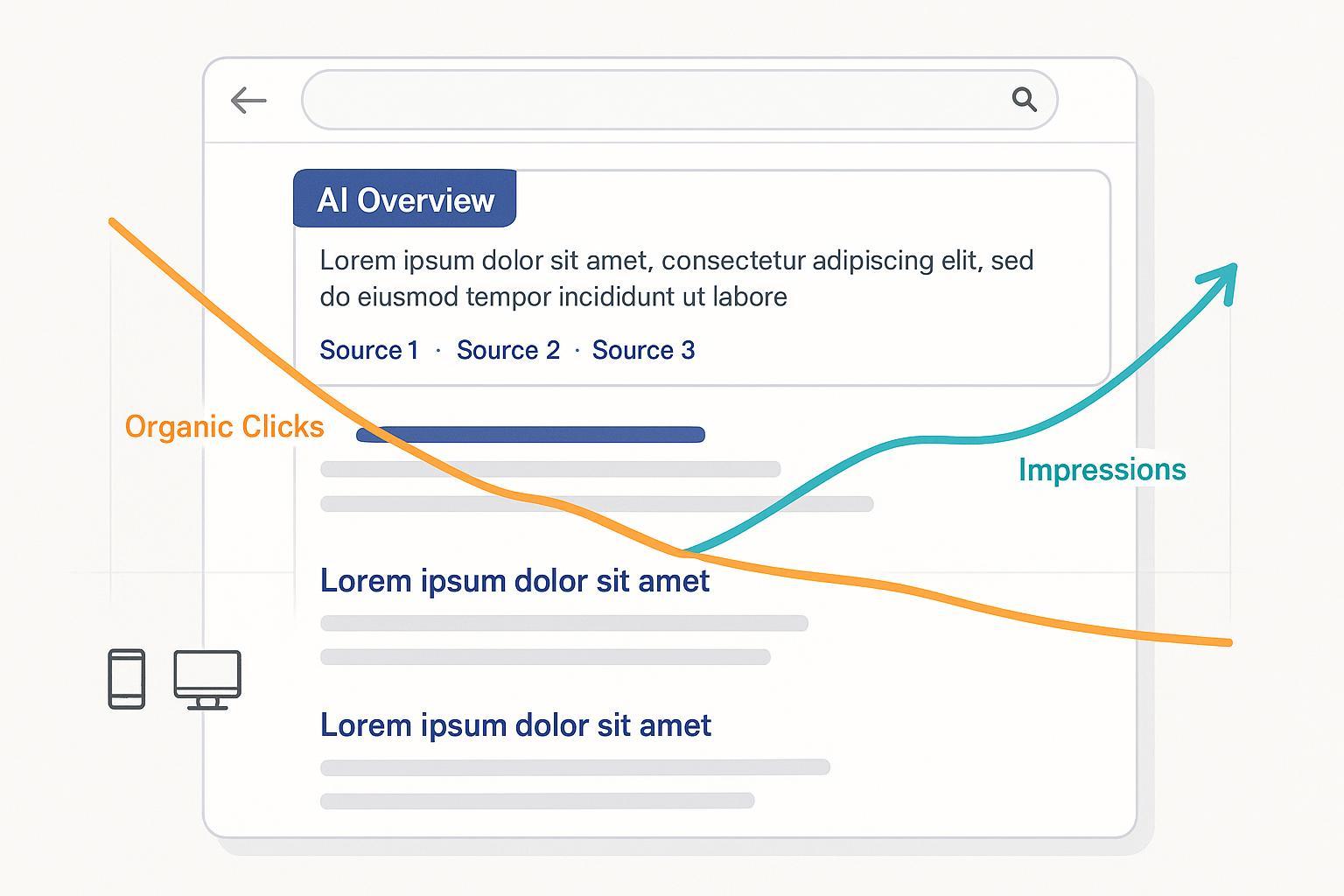The rise of zero-click searches in 2025 — and how creators should rewrite their traffic strategy

What changed on the SERP — and why it matters now
Zero-click behavior isn’t new, but it accelerated in 2025 as Google’s AI Overviews (formerly SGE) began answering more queries directly on the results page. In a March 2025 analysis, the Pew Research Center reported that when an AI summary appeared, users clicked traditional results less often and ended sessions without clicking more frequently; only a small fraction clicked links inside the summary itself, according to the detailed findings in the Pew Research short-reads (2025). Meanwhile, industry tracking shows a year-over-year dip in organic click share on desktop in both the U.S. and EU/UK, aligning with an uptick in zero-click outcomes as covered by Search Engine Land’s June 2025 analysis.
The bottom line for creators: you’ll see more impressions but fewer clicks for answerable queries. That requires two shifts—compete at the “answer layer” so your brand gets cited on-SERP, and build assets that are worth the click when users want to go deeper.
The numbers content leaders should know (and how to interpret them)
- In Pew’s U.S. panel (Mar 2025), AI summaries appeared for a non-trivial share of searches, and the presence of a summary correlated with lower click-through to traditional results and more no-click sessions. The study notes that summaries often cited multiple sources and tended to trigger more on longer, informational queries—key context for your content planning in 2025. See the detailed behavior breakdown in the Pew Research short-reads (2025).
- Desktop trendlines from Datos/SparkToro data featured by Search Engine Land (June 5, 2025) show organic click share falling and zero-click rates rising year-over-year in the U.S. and EU/UK. Treat exact percentages as methodology-specific, but the direction is consistent across reputable sources.
- Multiple large-scale keyword studies suggest AI Overviews prevalence grew through early–mid 2025. A Semrush analysis of 10M+ keywords reported AIO exposure roughly doubling from January to March 2025; see the methodology notes in Semrush’s AI Overviews study (July 2025). Ahrefs’ mid-2025 snapshots found AIOs in a meaningful minority of queries and documented notable CTR declines where AIOs co-occur with featured snippets; see Ahrefs’ AI Overviews analysis (May 2025).
- Google’s guidance emphasizes that helpfulness, expertise signals, and structured data improve eligibility for rich presentations. Their 2025 documentation explains how AI features may surface and cite content; see Google’s “AI features & your website” docs (2025).
For historical context on “zero-click” as a long-running trend, see the synthesis in SEO.com’s 2025 explainer. Use it directionally rather than as a definitive dataset.
Rethink your measurement: clicks are a metric, not the mission
Google Search Console now rolls AI Mode/AIO traffic into the standard “Web” performance reports; there’s no separate AIO impression metric to break out. That means you’ll need proxy indicators and a broader scorecard. Per Google and industry confirmations, see Google’s AI features docs (2025) alongside confirmations summarized by Search Engine Journal (June 2025) and practitioner notes such as Brodie Clark’s June 2025 explainer.
A practical 2025 scorecard for creators and SEO leads:
- Impressions and average position for priority queries (track deltas when AIO shows).
- Inclusion rates for featured snippets/AI Overviews (via third-party SERP feature trackers).
- Branded query growth and direct traffic lift (brand recall from on-SERP citations).
- Assisted conversions tied to organic discovery across sessions (lookback windows in analytics).
- Email/newsletter subscriber growth from pages designed to capture interest.
Tip: Expect impression growth without proportional clicks on informational, long-tail queries. Use internal anchor modules and content upgrades to funnel on-SERP attention into owned audience growth.
For a deeper primer on technical readiness and schema alignment, review our guide on CMS SEO best practices.
Compete at the answer layer: AEO patterns that work in 2025
Answer-engine optimization (AEO) is about being the source the SERP can quote. Practical patterns:
- Start pages with a concise definition or direct answer (40–70 words) followed by supporting detail.
- Use scannable H2/H3 structure with specific questions (who/what/why/how), then answer immediately.
- Add FAQ and HowTo sections when appropriate; ensure content is visible on-page (no hidden-only schema).
- Strengthen E-E-A-T: author bios with credentials, methodology sections, original visuals or data, and transparent update logs.
Two essential structured data patterns:
- FAQPage JSON-LD (visible Q&A on the page)
{
"@context": "https://schema.org",
"@type": "FAQPage",
"mainEntity": [{
"@type": "Question",
"name": "What is a zero-click search?",
"acceptedAnswer": {
"@type": "Answer",
"text": "A zero-click search is a query that ends without the user visiting a result, often because the answer appears directly on the results page via features like AI Overviews or featured snippets."
}
},{
"@type": "Question",
"name": "How can I qualify for AI Overviews?",
"acceptedAnswer": {
"@type": "Answer",
"text": "Structure content with clear questions and concise answers, add relevant schema like FAQPage or HowTo, and demonstrate first-hand expertise with author credentials, sources, and original insights."
}
}]
}
Reference implementation details and eligibility guidance in Google’s FAQPage structured data docs (2025).
- HowTo JSON-LD (for procedural content)
{
"@context": "https://schema.org",
"@type": "HowTo",
"name": "Add FAQ schema to a blog post",
"description": "A simple process to add FAQPage JSON-LD and validate it for rich results.",
"step": [{
"@type": "HowToStep",
"name": "Draft 3–5 FAQs",
"text": "Collect genuine user questions from your comments, GSC queries, and support tickets."
},{
"@type": "HowToStep",
"name": "Write concise answers",
"text": "Keep answers 40–70 words and include first-hand details or examples."
},{
"@type": "HowToStep",
"name": "Embed JSON-LD",
"text": "Add the FAQPage script to your page template and ensure the Q&A is visible in the HTML."
},{
"@type": "HowToStep",
"name": "Validate & publish",
"text": "Use Google’s Rich Results Test, fix errors, and republish."
}]
}
See full guidance in Google’s HowTo structured data docs (2025).
Device and intent nuance: design for mobile immediacy, keep desktop depth
- Mobile users skew toward quick answers and short dwell sessions. Place succinct definitions and key steps above the fold, then offer a clear path to deeper resources (calculators, templates) for those who tap through.
- Desktop remains valuable for complex comparisons, tools, and research workflows; prioritize fast UX and structured navigation that make depth rewarding.
- Expect AIO exposure to favor longer, informational queries. Align your content model so the first 100–150 words directly satisfy intent.
For evolving SERP behaviors and macro trends, track our synthesis of Google search statistics and changes.
Micro-workflow: building an FAQ block + schema the practical way (tool-agnostic)
Here’s a replicable workflow to earn eligibility for FAQ rich results and AIO citations:
- Collect questions from GSC queries and on-site search logs; prioritize those with informational intent.
- Write direct, 40–70-word answers with first-hand context (methods, benchmarks, screenshots).
- Publish a visible FAQ section on the page. Then add FAQPage JSON-LD mirroring the on-page Q&A.
- Validate with Google’s Rich Results Test; monitor inclusion via a SERP feature tracker.
Tools can help you systematize this. Platforms like QuickCreator can be used to structure Q&A blocks, enable schema-friendly layouts, and streamline publishing. Disclosure: QuickCreator is our product.
If you want AI-assisted drafting for FAQs that match your headings and intent, you can also explore our AI blog writer overview, which fits neatly into a Q&A-first outline.
Create “click-worthy depth” the SERP can’t compress
To counter on-SERP satisfaction, ship assets that genuinely require a visit:
- Interactive calculators (ROI, pricing, break-even) and diagnostic tools.
- Downloadable templates, checklists, and frameworks.
- Side-by-side comparisons with proprietary data and screenshots.
- Original surveys, benchmark studies, and case studies (with methods and sample sizes).
Pair these with subtle conversion paths: email courses, demo sign-ups, or resource libraries. Treat impressions as the top of a longer journey rather than a failed click.
Sector notes: YMYL and local
- YMYL topics (health, finance, legal, education) often see higher AIO and snippet activity in 2025 studies. Compete with documented expertise: author credentials, citations to primary sources, and conservative phrasing. When in doubt, prefer official data and name the publisher and year in-line.
- Local queries have shown notable AIO experimentation; pair robust on-page answers with up-to-date listings, reviews, and location pages. Continue investing in Maps and local verticals where user actions still require clicks and calls.
What to watch next (and how to update your plan)
- AIO coverage by query class: informational long-tail vs commercial-intent queries.
- Google’s linking behavior inside summaries (source counts and placement).
- Device-level CTR shifts and regional differences as new datasets publish.
- Any Search Console enhancements that expose AI features separately.
Keep a monthly review cadence. When credible new studies land, update your schema, layouts, and KPIs accordingly.
A note on sources and methodology
- Behavioral shifts with AI summaries are described by the Pew Research short-reads (2025), based on a U.S. panel from March 2025.
- Desktop zero-click and organic click-share trends are covered by Search Engine Land’s June 2025 analysis, which cites Datos/SparkToro datasets.
- AIO prevalence and CTR effects are detailed in Semrush’s July 2025 study and Ahrefs’ mid-2025 analyses.
- Implementation references are from Google’s AI features & your website docs (2025) and structured data specs for FAQPage and HowTo.
Soft CTA
If you want a faster way to operationalize Q&A-first structures, schema, and SEO-friendly publishing, you can explore QuickCreator—the platform we build for creators and teams.
Change log
- Updated on 2025-10-01: Initial publication with 2025 sources; will refresh as new AIO metrics and device-level datasets are released.

